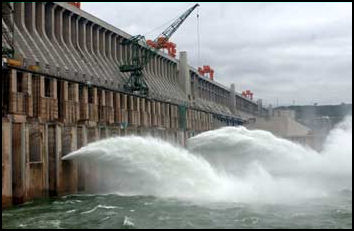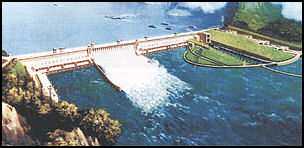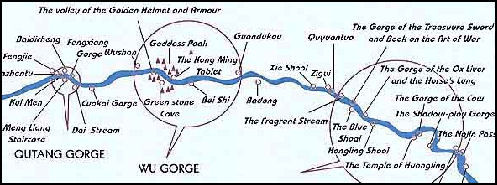THREE GORGES DAM PROJECT

The Three Gorges Dam s the world's largest hydropower dam and the world's largest concrete structure. Opened in 2003 on on the lower Chang (Yangtze) River, it boasts 22.5 million kilowatts of generating capacity and has been called China's most ambitious project since the Great Wall and the world’s largest construction job. Comprised of one massive dam and several smaller dams, it named after the Three Gorges of the Yangtze River, one of China's great natural wonders, which the reservoirs behind the dams have partly submerged. The Three Gorges Dam is the 22nd largest dam in the world if al kinds of dams are included.
Large dam projects like the Three Gorges Dam are becoming increasingly unpopular. Most Chinese support the project as a way of bringing development and progress to China. Many international groups have opposed it on environmental and humanitarian grounds. The World Bank was originally supposed to provide loans to help finance the project and relocate people but changed its policy due to pressure from the United States and environmental and human rights groups. [Source: Arthur Zich, National Geographic, September 1997]
Three Gorges Dam is not only the world's largest but also the costliest hydropower project ever undertaken. When it was approved in 1992, its cost was estimated at $8.3 billion. According to official figures, the venture cost China about $23 billion, but outside experts estimate it may have cost double that amount. Some have said it may have cost as much $88 billion.
The Three Gorges Dam may be the world’s largest producer of renewable energy. It holds back, 10.3 trillion gallons of water. It has a capacity of 18,200 megawatts of electricity. The huge dam is meeting the government’s goal of producing pollution-free electric power, the government said, generating 84 billion kilowatt-hours of electricity in 2010. But in the process of its construction 1,350 villages were submerged and 1.3 million people displaced from their homes.
In November 2009 there were plans to fill the reservoir behind Three Gorges Dam to maximum height of 175 meters, representing the completion of the project but when the water level reached 171 meters filling the reservoir was abruptly stopped, according to the Chinese government, because of lack of water coming from upstream and worries about droughts downstream. The magazine Caijing reported the stoppage may also had something to do with warnings that rising waters were increasing landslide pressures as the soil around the dam became saturated and unsettled.
See Separate Articles: PROBLEMS WITH THE THREE GORGES DAM factsanddetails.com ; YANGTZE RIVER factsanddetails.com ;THREE GORGES OF THE YANGTZE RIVER factsanddetails.com ; WATER PROJECTS AND FLOOD CONTROL IN CHINA factsanddetails.com; DAMS IN CHINA: HYDROPOWER AND BIG PROJECTS AND DISASTERS factsanddetails.com; CONTROVERSIAL DAMS IN TIBET, SICHUAN AND YUNNAN factsanddetails.com; Articles on ENERGY IN CHINA factsanddetails.com ; U.S. Energy Information Administration Report on Energy in China eia.gov/international/analysis ; China Sustainable Energy Program efchina.org ; Mekong River Commission (MBC) mrcmekong.org ; Three Gorges Dam: China Digital Times tagged articles chinadigitaltimes.net ; BBC Pictures /news.bbc.co.uk ; Maps of China Maps of China ; Wikipedia Wikipedia
RECOMMENDED BOOKS:““The River Dragon Has Come!: Three Gorges Dam and the Fate of China's Yangtze River and Its People” by Dai Qing, John G. Thibodeau, et al. (1998) Amazon.com; “Geographical Overview of the Three Gorges Dam and Reservoir, China: Geologic Hazards and Environmental Impacts: USGS Open-File Report 2008-1241" by Lynn M Highland and United U S Department of the Interior (2013) Amazon.com; China’s Hydro-politics in the Mekong: Conflict and Cooperation in Light of Securitization Theory” (2018) Amazon.com; “Dams, Migration and Authoritarianism in China: The Local State in Yunnan” by Sabrina Habich (2015) Amazon.com; “Petitions and Power: A Story of the Migrants of a Dam in China” (2018) Amazon.com; “Large Dams in China-History,Achievement and Prospect” by Chinese Committee on Large Dams (1987) Amazon.com; “Dams and Development in China: The Moral Economy of Water and Power” by Bryan Tilt Amazon.com
Three Gorges Dam

The Three Gorges Dam is a cement dam that is 186 meters (610 feet) high and runs for 1.3 miles (2.3 kilometers) across the Yangtze River. Located near Yichang in Hubei Province, it will contain twenty-six 400-ton turbines, the world's largest, when completed. The reservoir produced by dam will be 370 miles long (600 kilometers), about the same length as Lake Superior. A total of 200 miles of canyons with spectacular limestone formations will lie under water when the Three Gorges Dam is completed in 2009 at a cost of $30 billion.
Three Gorges is the world’s largest dam in terms of water displacement, flood control; and power generation. There are higher and wider dams but none come close to producing as much electricity — 18,200 megawatts, enough energy to supply 10 percent of China's electricity needs and the equivalent of the electricity produced by 18 nuclear power plants. The electrical generating capacity of the world’s next four largest dams are 12,600 megawatts by Itaipú in Brazil, 10,300 megawatts by Guri in Venezuela, 6,809 by Grand Coulee in the U.S., and 6,400 in Sayano-Shushensk in Russia.
Three Gorges Dam is five times wider than Hoover dam and is as tall as a 60 story building. Large ships will by bypass the dam via two five-stage locks that will raise or lower the ships 500 feet. Smaller vessels will be moved up and down on a ship elevator.
About 60,000 workers were employed by the Three Gorges Dam project, with about 25,000 working on the dam itself. They used 32-ton dump trucks and giant drills that cut through granite. One dump truck driver told National Geographic that her earned 25 cents a truckload, about two dollars a day. He lived with his coworkers in a hillside shed without water or toilet facilities.
History of the Three Gorges Dam Project
The idea for huge dam project on the Yangtze was first proposed in 1916 by Sun Yat-sen and later pushed by Mao Zedong, who wrote a poem about it: “Walls of stone will stand upstream to the west, to hold back Wushan’s clouds and rain, until a smooth lake rises in the narrow gorges.” .
Japanese engineers did some survey work around the dam site when they occupied China. This work was continued U.S. Bureau of Reclamation under the Kuomintang and by the Soviets in the early years under the Communists. The first step of the Three Gorges project was the completion of the 176-foot-high Gezhou Dam, which opened in 1989 after 20 years of construction.
The current dam was a pet project of rFormer premier Li Peng, known best for his role in the Tiananmen Square massacre. He was trained as an engineer in the great Soviet tradition of grand public works projects. In 1992, after a four year debate, the Chinese government approved a plan. Li was the driving force behind the project. In 1992, Li managed to suppress opposition to the project at home and pushed for approval for the dam. Experts say the effort was motivated by Li's desire to rebuild his political legacy in the aftermath of the 1989 Tiananmen Square crackdown on democracy. The damming of the Yangtze “is an event that not only inspires people but demonstrates the greatness of the achievement of China's development”, Li said in 1997, presiding over the ceremony to mark the river's diversion. [Source: Antoaneta Bezlovam Asia Times, November 4, 2009]
Construction of the Three Gorges Dam Project
Construction formally began in 1994. In November 1997, the Yangtze River was closed with loads of huge of rocks dropped by 32-ton dump trucks into the river. Both Chinese president Jiang Zemin and Premier Li Peng were on hand for the event. The river was diverted into a 2.3-mile-long canal, using a massive 580-meter-long, 140-meter-high temporary coffer dam so the Three Gorges dam could be built in the river bed.
In early June 2003, China blocked the Yangtze River and began the filling in what will be a 600-kilometer-long reservoir. Live television broadcasts showed water in the sluice being slowly cut off. Water rose at a rate of about a half centimeter every hour until mid June when the water reached an interim level of 135 meters above sea level, 100 meters above what it was before. and commercial ships began passing through the locks. As the water rose, the last hold holdouts gathered their possessions and Chinese medicine suppliers gathered snakes, scorpions, and insects scrambling in confusion as their homes were submerged. In August two 700-megawatt generators began operating.
The main wall of Three Gorges Dam was completed in May 2006, nine months ahead of schedule, and dam was declared finished. A ceremony was held to honor 100 workers who had died as of that time. The last cofferdam was blown up in June 2006, unleashing water into the hydroelectric facilities and allowing the main dam to hold back the full weight of the Yangtze River. The explosions, produced with 191 tons of dynamite, sent water shooting 30 meters into the air. Before the explosions the water was zapped with electricity to keep fish out of harm’s way.
Since the start of construction in 1992 about 16 million tons of concrete have been poured into the giant barrier across the Yangtze river, creating a reservoir that stretches almost the length of Britain and drives 26 giant turbines. Installation of the 26 generator turbines and other equipment was due to be completed in 2009, when the reservoir will reach its full level — 175 meters above sea level, 140 meters higher than it was in 2002, and 40 meters higher than what it was in 2003, and be 660 kilometers long. The reservoir is now known as Emerald Drop Lake.

Area submerged by the dam
Benefits of the Three Gorges Dam
Among the benefits of the Three Gorges Dam will be the creation of loads of electricity, protection for millions of people from floods, and the provision of waters for millions of acres of irrigated land. The Three Gorges Dam will control floods that have killed 300,000 people in this century alone; provide the annual energy produced by the burning of 50 million tons of coal a year; and create the world's largest water storage reservoir. The dam gives Chinese planners additional flexibility in managing storage and release of water to adapt to extremes in rainfall and drought.
The dams and reservoirs will improve the navigability of the Yangtze River creating a 660-kilometer-long reservoir of calm, deep water; widen shipping lanes; and eliminate strong currents and obstacles such as rocks and sandbars. The Three Gorges Dam will have three passage locks and the dam. The dam at has have just one.
Beijing argues that Three Gorges Dam is desperately needed to bring jobs and an improved quality of life for tens of millions of people living the interior of China, which lags way behind the coastal areas in terms of economic development and prosperity. Many local people support the project because of the flood control and economic benefits it brings.
When it is completed 10,000 ton freighters will be able to come up the river, providing industry with access to cheap labor in central China and major river and sea trade routes. The reservoir is so large that it raises temperatures and affects humidity, wind patterns and agriculture in the area. This may help farmers by bringing more rainfall.
Raising the Water Levels at Three Gorges Dam
Elaine Kurtenbach of AP wrote: “The water level in the vast reservoir behind it hit its peak height of 574 feet (175 meters) in October 2010 according to project operator, the China Three Gorges Project Corp. The previous record was 567 feet (172.8 meters), set in 2008, the year the generators began operating. In the future, the water level will be adjusted depending on flood-control needs but kept within 100 feet (30 meters) of the maximum. [Source: Elaine Kurtenbach, AP, October 26 2010]
“Company chairman Cao Guangjing called Tuesday's feat a "historical milestone." He said annual power generation will reach 84.7 billion kilowatt hours, enabling "the project to fulfill its functions of flood control, power generation, navigation and water diversion to the full."

“Warnings of damage While raising the water level increases the electricity production of the dam, some geologists have warned that damming up too much water in the reservoir carries a heightened risk of landslides, earthquakes and prolonged damage to the river's ecology. As officials attempted to raise water levels in the reservoir last fall, at least one town had to evacuate dozens of residents after a hairline crack appeared on the slopes above homes.
Later it was revealed that Three Gorges Dam operators hoarded water in order to achieve the 175-meter maximum, on the not unwarranted but unfulfilled assumption that spring rains would cover the temporary downstream shortage. Peter Lee wrote in the Asia Times, “The government subsequently admitted that the large, shallow lakes that form flood basins in the middle Yangtze - particularly Boyang and Dongting Lakes - were lower than usual as a result and dried up dramatically during the unprecedented drought, exacerbating local hardships.” [Source: Peter Lee, Asia Times, June 11, 2011]
“There is also the issue of whether the reputedly greedy and callous operators of the TGD hydropower station resisted releasing drought-relief water from the dam so that optimum head for power generation (and profits) could be maintained. They probably did, and it took a highly publicized directive from the Chinese government to open the floodgates and send 3.7 billion tons of water (about 10 percent of the reservoir's capacity) downstream.”
Image Sources: Nolls China website http://www.paulnoll.com/China/index.html ; CNTO; Xindua, ESWIN. Telegraph, Envirnonmental News; NASA, Nature Conservancy ; YouTube
Text Sources: New York Times, Washington Post, Los Angeles Times, Times of London, National Geographic, The New Yorker, Time, Newsweek, Reuters, AP, Lonely Planet Guides, Compton’s Encyclopedia and various books and other publications.
Last updated June 2022
